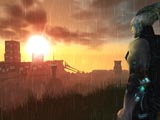
| Publisher: Micro Forte | Developer: Micro Forte |
| Previewer: Sarcasmorator | Expected Release: Q2 2002 |
|
The Australian developer behind last year’s tactical spinoff to PC-RPG mainstay Fallout, Micro Forte prepares to soon release a new entry, Citizen Zero, into the crowded massively multiplayer online RPG market. But while there are many MMORPGs to be played, most take place in traditional fantasy settings; Citizen Zero moves the genre out of the swords-and-sorcery backdrop and into a grittily futuristic and high-tech vein. Termed a massively multiplayer online action-adventure game, but with RPG-style character building, the game takes place on the ex-penal colony NE6744, dubbed “Neo-Eden” by its inhabitants, freed of its caretaker Guardians 50 years previously after the “Great Riot.” Since the Guardians fled, a new society has arisen on Neo-Eden and two other planets in its system, the tropical, swampy world of Ulrua and the blasted desert planet Trinn. Earth is unaware of the revolution and continues to ship new loads of mind-wiped prisoners to the colony, each implanted with an identity chip which restricts their movements. But some new arrivals are not constrained by these chips – they manage to break through the limiting by force of will and develop new strengths as a result, and are free to move about and between the worlds through the use of abandoned teleportation devices. These individuals are called “Zeroes” by the ruling DeMannon’s Ladder Council, and players take control of one of these sought-after new arrivals, able to venture where, and use machinery and equipment which ordinary citizens cannot. Players choose from one of three races; the standard Humans, the bio-mechanical Cybrids, or the tribal alien Beziel, who were used as slaves by the Guardians. With its mind erased, each character is a blank slate from the outset, with no name or past and, as a Zero, actively pursued by the various factions of Neo-Eden. These factions, collectively called the Overarchy, provide the impetus for gameplay, assigning missions and doling out rewards upon completion. These missions do not simply use pre-set objectives, however; they are tailored to each player’s ability and playing style, providing each player with a unique experience; freelancing is an option, as well. Unique, too, is each character’s past; memories emerge with time as flashbacks from the chip-induced fog, revealing personal details and raising new questions, though the full picture will never be revealed. Character creation allows for a variable level of flexibility; if a player does not wish to tweak every detail of their avatar, the computer can fill in the blanks, while micro-management types can fiddle with the details, including color, adjustable body types for characters with differing physical strengths and a variety of movement animations. After selecting some core skills and attributes at the outset, players are sent out into the world to take on missions. If a character dies, it is reborn at the local revivification tower, relic of the penal colony that ensured no prisoner could use suicide as a means to escape their sentence. This comes with a price, however – the administrators of these facilities, Revivification, Inc., charge a fee for their service which is either taken out of the player’s savings or worked off under contract. As a now-civilized colony, players are not free to raise hell in Neo-Eden as they wish. Getting caught committing a crime by a security camera, police patrol or NPC or being reported by another player-character means pursuit and fines, property loss, incarceration and downgrading of revivification rights if captured. Characters who commit repeated and serious crimes will also be more heavily hunted, though it is possible to act as a career criminal if desired and the player is cunning enough. Citizen Zero’s structure is such that it makes player-killing difficult – players can only fight each other in an agreed-upon duel, within designated “danger zones” in the badlands and depths of the city of DeMannon’s Ladder or as part of cross-purpose missions in which two competing characters or groups pursue opposing goals. Aside from the former prison population, the worlds of Citizen Zero are also home to the Machina, rogue installations of the self-replicating and repairing bio-machinery – smaller units of which are called automata and macrons – originally designed to build and maintain the prison colony. Now feral, the machines spread over the planet without obvious purpose. These beings are part of what players will fight against in the game. Combat is in real-time, with variables like accuracy and damage affected by individual statistics. The game also features wide-ranging stories in its persistent world, introduced and monitored by the game’s administrators and authored by professional writers, which will cause changes in the game’s overall structure, the effects eventually filtering down to players. Other features include safe, home-base apartments, automated banking and a variety of usable vehicles. Offering a science-fiction alternative to the fantasy-drenched MMO game genre, Citizen Zero is one to keep an eye on when it’s released around the halfway point of this year. |
|


